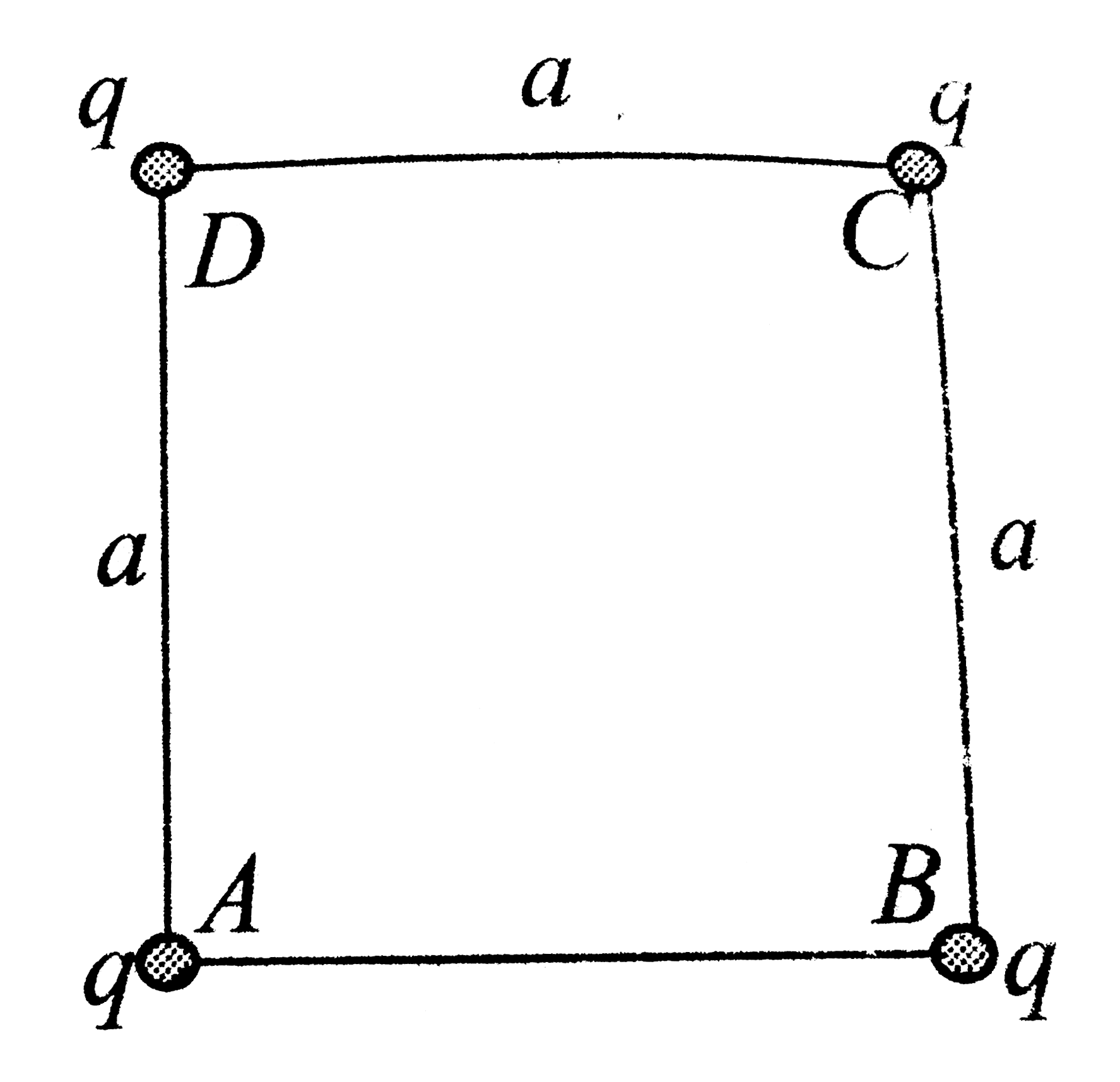Charges Q−q,Q,−q are placed at the corners A,B,C,D of a square respectively. If the resultant force on the charge Q is zero due to other charges, what is the relation between Q and q?
Q=−2√2q
Q=−2q
Q=−√2q
Q=−12√2q
The correct Answer is:a
To find the relation between the charges Q and q such that the resultant force on the charge Q at corner A of the square is zero due to the other charges at corners B and C, we can follow these steps:
Step 1: Identify the charges and their positions
- Place the charges at the corners of a square:
- Charge Q at corner A
- Charge −q at corner B
- Charge Q at corner C
- Charge −q at corner D
Step 2: Calculate the forces acting on charge Q
- The force on charge Q due to charge −q at B (denote this force as FB):
FB=k⋅|Q⋅(−q)|A2=k⋅Q⋅qA2
This force acts towards charge −q at B.
- The force on charge Q due to charge Q at C (denote this force as FC):
FC=k⋅|Q⋅Q|A2=k⋅Q2A2
This force acts away from charge Q at C.
Step 3: Analyze the direction of the forces
- The force FB acts towards B (downwards).
- The force FC acts away from C (to the right).
Step 4: Resolve the forces
- Since FB and FC are at right angles to each other, we can find the resultant force FBC using the Pythagorean theorem:
FBC=√F2B+F2C
Step 5: Set the resultant force equal to the force due to charge Q at A
- For the resultant force on charge Q to be zero, the force FA (which is the force due to the other charges) must equal the force FBC:
FA=FBC
Step 6: Substitute the expressions for forces
- Substitute the expressions for FB and FC:
k⋅Q22A2=√(k⋅Q⋅qA2)2+(k⋅Q2A2)2
Step 7: Simplify the equation
- Square both sides to eliminate the square root:
(k⋅Q22A2)2=(k⋅Q⋅qA2)2+(k⋅Q2A2)2
- This leads to:
k2⋅Q44A4=k2⋅Q2⋅q2A4+k2⋅Q4A4
Step 8: Cancel common terms and solve for q
- Cancel k2/A4 from both sides:
Q44=Q2⋅q2+Q4
- Rearranging gives:
Q44−Q4=Q2⋅q2
- Simplifying:
−3Q44=Q2⋅q2
- Dividing by Q2 (assuming Q≠0):
q2=−3Q24
- Taking the square root gives:
q=±√−34Q=±√32Q
Final Relation
Thus, the relation between Q and q is:
q=±√32Q
- Place the charges at the corners of a square:
- Charge Q at corner A
- Charge −q at corner B
- Charge Q at corner C
- Charge −q at corner D
- The force on charge Q due to charge −q at B (denote this force as FB):
FB=k⋅|Q⋅(−q)|A2=k⋅Q⋅qA2
This force acts towards charge −q at B.
FC=k⋅|Q⋅Q|A2=k⋅Q2A2
This force acts away from charge Q at C.
- The force FB acts towards B (downwards).
- The force FC acts away from C (to the right).
- Since FB and FC are at right angles to each other, we can find the resultant force FBC using the Pythagorean theorem:
FBC=√F2B+F2C
- For the resultant force on charge Q to be zero, the force FA (which is the force due to the other charges) must equal the force FBC:
FA=FBC
- Substitute the expressions for FB and FC:
k⋅Q22A2=√(k⋅Q⋅qA2)2+(k⋅Q2A2)2
- Square both sides to eliminate the square root:
(k⋅Q22A2)2=(k⋅Q⋅qA2)2+(k⋅Q2A2)2
- This leads to:
k2⋅Q44A4=k2⋅Q2⋅q2A4+k2⋅Q4A4
- Cancel k2/A4 from both sides:
Q44=Q2⋅q2+Q4
- Rearranging gives:
Q44−Q4=Q2⋅q2
- Simplifying:
−3Q44=Q2⋅q2
- Dividing by Q2 (assuming Q≠0):
q2=−3Q24
- Taking the square root gives:
q=±√−34Q=±√32Q
Thus, the relation between Q and q is:
q=±√32Q
Topper's Solved these Questions
- ELECTRIC CHARGE, FIELD & FLUXBOOK - A2ZCHAPTER - ELECTRIC CHARGE, FIELD & FLUXEXERCISE - Electric Field Due To Point Charge
25 Videos
- ELECTRIC CHARGE, FIELD & FLUXBOOK - A2ZCHAPTER - ELECTRIC CHARGE, FIELD & FLUXEXERCISE - Electric Field And Motion
37 Videos
- DUAL NATURE OF RADIATION AND MATTERBOOK - A2ZCHAPTER - DUAL NATURE OF RADIATION AND MATTEREXERCISE - Section D - Chapter End Test
30 Videos
- ELECTRIC POTENTIAL & CAPACITANCEBOOK - A2ZCHAPTER - ELECTRIC POTENTIAL & CAPACITANCEEXERCISE - Section D - Chapter End Test
29 Videos
Similar Questions
Four identical charges q are placed at the corners of a square of side a. Find the potential energy of one of the charges due to the remaining charges.
 .
.
View SolutionFour charges +q,+2q,+3q and +4q are placed at the four corners ABCD of a square of side a. Calculate the field and potential at the centre of the square.
View Solution
Knowledge Check
Equal charges q are placed at the four corners A,B,C,Dof a square of length a. The magnitude of the force on the charge at B will be
A3q24πε0a2B4q24πε0a2C(1+2√22)q24πε0a2D(2+1√2)q24πε0a2Equal charges Q are placed at the four corners A, B, C, D of a square of length a. The magnitude of the force on the charge at B will be
A3Q24πε0a2B4Q24πε0a2C(1+1√22)Q24πε0a2D(2+1√2)Q24πε0a2Four charges +Q,−Q,+Q,−Q are placed at the corners of a square taken in order. At the centre of the square
AE=0,V=0BE=0,V≠0CE≠0,V=0DE=0,V≠0
Four point charges Q.q Q and q are placed at the corners of a square side 'a' as shown in the figures.

Find the resultant electric force on a charge Q,
View SolutionFour point charges Q , q Q and q are placed at the corners of a square of side 'a' as shown in the Fig. Find the
resultant electric force on a charge Q
View SolutionFour charges Q-Q, Q-Q are placed at the corners of a square as shown . The potential is zero at points

View SolutionPoint charges g, -q, 2Q and Q are placed in order at the corners A, B, Cand D of a square of side 2b. If the field at the midpoint of CD is zero, then qQ is
View SolutionThree charge +Q,+Q and −Q are placed at the corners of an equilateral triangle. The ratio of the force on a positive charge to the force on the negative charge will be equal to
View Solution
